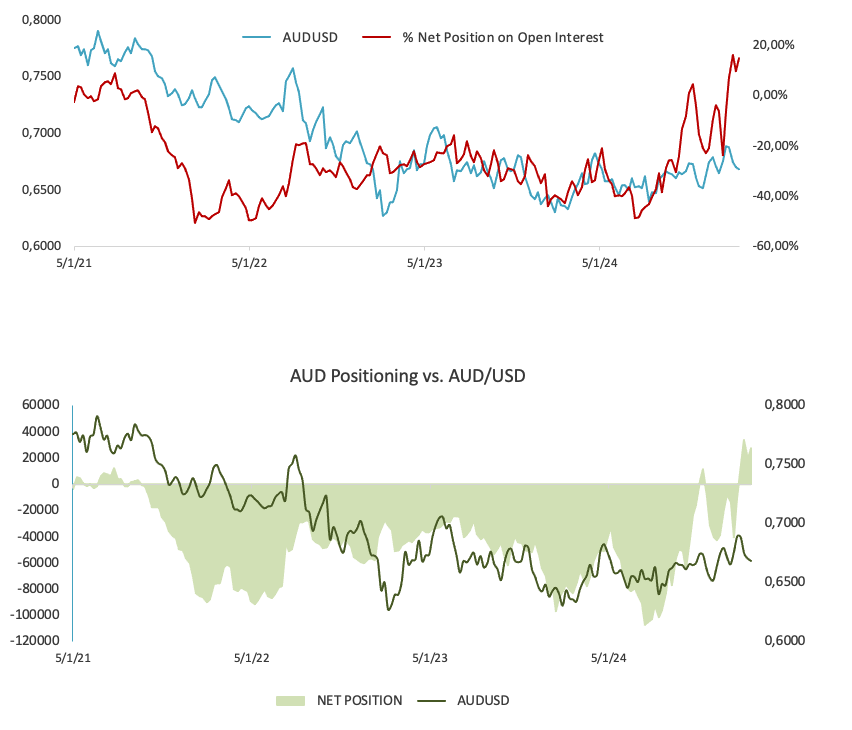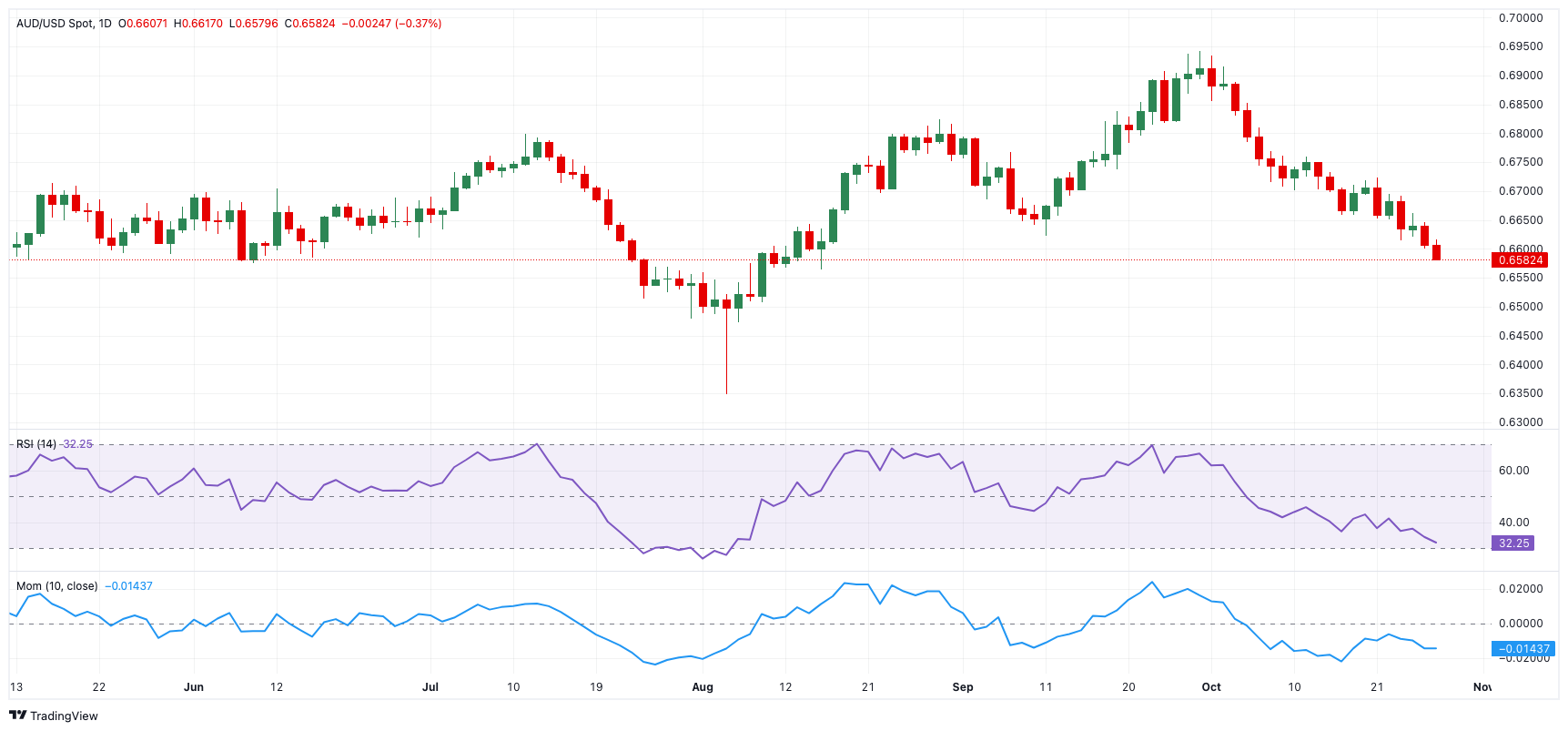- AUD/USD broke below the 0.6600 level, opening the door to extra losses.
- The US Dollar traded amidst an inconclusive range near recent highs.
- The pair breached the key 200-day SMA, exposing further weakness.
AUD/USD remained under pressure at the beginning of the week, adding to Friday’s retracement to print new lows near 0.6580 and extending the recent breakdown of the critical 200-day simple moving average (SMA), currently at 0.6627.
Despite the US Dollar's (USD) subdued performance, which saw mild losses against the backdrop of an equally tepid recovery in risk assets, the Australian dollar struggled in response to lingering doubts over the effectiveness of China’s recently announced stimulus measures.
Further gains in copper prices in combination with another marginal uptick in iron ore prices further underscored the market’s mixed sentiment about China’s economic outlook and did nothing to curb the selling sentiment hurting the Aussie Dollar.
On the monetary policy front, the Reserve Bank of Australia (RBA) held its cash rate steady at 4.35% during its September meeting. While Governor Michele Bullock acknowledged inflationary risks, she downplayed the possibility of a rate hike in the near term.
Later, meeting Minutes revealed a more dovish tone than in August, suggesting rates might hold steady for now. Market sentiment indicates a 50% chance of a 25-basis-point rate cut by year-end, with expectations that the RBA may be one of the last G10 central banks to ease rates as growth and inflation cool.
However, in his latest remarks, Deputy Governor Andrew Hauser warned that expectations for substantial RBA rate cuts may be overestimated. He noted that the neutral rate is estimated between 3% and 4%, implying that the current rate of 4.35% is not overly restrictive.
While potential rate cuts by the Federal Reserve later this year could offer some support to AUD/USD, uncertainties surrounding China’s economic trajectory are expected to weigh heavily on the pair.
In Oz, the next relevant release will be the RBA’s Monthly CPI Indicator, along with the Inflation Rate for the third quarter, all expected on October 30.
On the positioning front, speculative net longs in AUD rose to two-week tops in the week ending October 22, according to the CFTC Positioning Report. In addition, open interest retreated for the second week in a row. During that period, AUD/USD navigated a consolidative range above the 0.6650 zone, although always keeping close track of developments around China and the implementation of its stimulus packages.
AUD/USD daily chart
AUD/USD short-term technical outlook
Extra losses might send the AUD/USD to its October low of 0.6579 (October 28), ahead of the 2024 low of 0.6347 (August 5).
On the upside, there is an intermediate resistance at the 100-day and 55-day SMAs of 0.6694 and 0.6740, respectively, before hitting the 2024 top of 0.6942 (September 30) and the critical 0.7000 barrier.
The four-hour chart shows that the negative leg continues in place. That said, initial support is at 0.6579, followed by 0.6347. On the upside, the initial resistance level is the 55-SMA at 0.6661, followed by 0.664 and then 0.6723. The RSI decreased to about 33.
Information on these pages contains forward-looking statements that involve risks and uncertainties. Markets and instruments profiled on this page are for informational purposes only and should not in any way come across as a recommendation to buy or sell in these assets. You should do your own thorough research before making any investment decisions. FXStreet does not in any way guarantee that this information is free from mistakes, errors, or material misstatements. It also does not guarantee that this information is of a timely nature. Investing in Open Markets involves a great deal of risk, including the loss of all or a portion of your investment, as well as emotional distress. All risks, losses and costs associated with investing, including total loss of principal, are your responsibility. The views and opinions expressed in this article are those of the authors and do not necessarily reflect the official policy or position of FXStreet nor its advertisers. The author will not be held responsible for information that is found at the end of links posted on this page.
If not otherwise explicitly mentioned in the body of the article, at the time of writing, the author has no position in any stock mentioned in this article and no business relationship with any company mentioned. The author has not received compensation for writing this article, other than from FXStreet.
FXStreet and the author do not provide personalized recommendations. The author makes no representations as to the accuracy, completeness, or suitability of this information. FXStreet and the author will not be liable for any errors, omissions or any losses, injuries or damages arising from this information and its display or use. Errors and omissions excepted.
The author and FXStreet are not registered investment advisors and nothing in this article is intended to be investment advice.
Recommended Content
Editors’ Picks

EUR/USD clings to daily gains near 1.0300 after US PMI data
EUR/USD trades in positive territory at around 1.0300 on Friday. The pair breathes a sigh of relief as the US Dollar rally stalls, even as markets stay cautious amid geopolitical risks and Trump's tariff plans. US ISM PMI improved to 49.3 in December, beating expectations.

GBP/USD holds around 1.2400 as the mood improves
GBP/USD preserves its recovery momentum and trades around 1.2400 in the American session on Friday. A broad pullback in the US Dollar allows the pair to find some respite after losing over 1% on Thursday. A better mood limits US Dollar gains.

Gold retreats below $2,650 in quiet end to the week
Gold shed some ground on Friday after rising more than 1% on Thursday. The benchmark 10-year US Treasury bond yield trimmed pre-opening losses and stands at around 4.57%, undermining demand for the bright metal. Market players await next week's first-tier data.

Stellar bulls aim for double-digit rally ahead
Stellar extends its gains, trading above $0.45 on Friday after rallying more than 32% this week. On-chain data indicates further rally as XLM’s Open Interest and Total Value Locked rise. Additionally, the technical outlook suggests a rally continuation projection of further 40% gains.

Week ahead – US NFP to test the markets, Eurozone CPI data also in focus
King Dollar flexes its muscles ahead of Friday’s NFP. Eurozone flash CPI numbers awaited as euro bleeds. Canada’s jobs data to impact bets of a January BoC cut. Australia’s CPI and Japan’s wages also on tap.

Best Forex Brokers with Low Spreads
VERIFIED Low spreads are crucial for reducing trading costs. Explore top Forex brokers offering competitive spreads and high leverage. Compare options for EUR/USD, GBP/USD, USD/JPY, and Gold.

